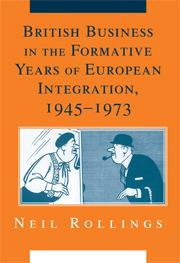Book contents
- Frontmatter
- Contents
- List of Tables and Figure
- Series Editors' Preface
- Acknowledgements
- Abbreviations
- 1 Introduction
- PART I ECONOMIC REALITIES
- 2 Trade and Protection
- 3 Overseas Investment, Corporate Strategy, and European Integration
- PART II THE DEVELOPMENT OF PERCEPTIONS OF EUROPEAN INTEGRATION
- PART III EUROPEAN INTEGRATION AS MORE THAN TARIFFS
- Conclusion
- Index
3 - Overseas Investment, Corporate Strategy, and European Integration
from PART I - ECONOMIC REALITIES
Published online by Cambridge University Press: 02 December 2009
- Frontmatter
- Contents
- List of Tables and Figure
- Series Editors' Preface
- Acknowledgements
- Abbreviations
- 1 Introduction
- PART I ECONOMIC REALITIES
- 2 Trade and Protection
- 3 Overseas Investment, Corporate Strategy, and European Integration
- PART II THE DEVELOPMENT OF PERCEPTIONS OF EUROPEAN INTEGRATION
- PART III EUROPEAN INTEGRATION AS MORE THAN TARIFFS
- Conclusion
- Index
Summary
Trading patterns provide a clear picture of economic relationships between countries but this is an incomplete picture because such relationships can also exist in the form of overseas investment. Incorporation of this part of the story is particularly important for the years after the Second World War as it marked a clear and extensive period of internationalization of production and of growth in multinational enterprise. Much of this is associated with the internationalization of American business, particularly its growing role in Western Europe, but Britain remained a heavy overseas investor too. In order to understand how Britain's economic relationship with the EC was developing, the pattern and form of its overseas investment needs to be considered. Traditionally Britain was a global investor but this became increasingly concentrated on the Commonwealth countries, much like the story of exports. With regard to European integration, it has been conventional to highlight the resulting shift in US foreign direct investment (FDI) away from Britain to the six European Community member states from the late 1950s. It has also been suggested that British overseas investment was slow to shift away from the Commonwealth countries to Western Europe and the United States, which were growing faster. As British firms were more concentrated and more internationalized than their continental European counterparts, this was a missed opportunity, it has been claimed, to follow the example of American multinationals and exploit the advantages of European integration.
- Type
- Chapter
- Information
- Publisher: Cambridge University PressPrint publication year: 2007



